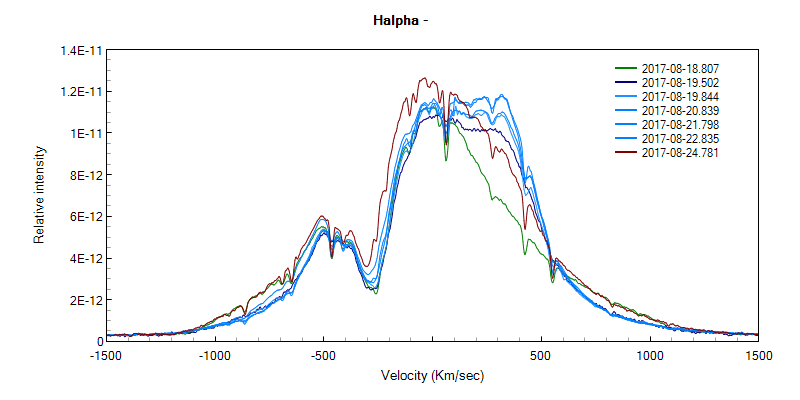Page 12 of 19
Re: New transcient, perhaps a nova
Posted: Sun Aug 20, 2017 10:38 am
by Francois Teyssier
An update with Terry's spectrum which confirms and precises the fast change of the Balmer lines profiles
Spectra : Joan, Paolo, Terry, François

- novasct2017_Halpha2.png (40.86 KiB) Viewed 7949 times
François
Re: New transcient, perhaps a nova
Posted: Sun Aug 20, 2017 4:35 pm
by Joan Guarro Flo
Hi,
In the _nova*.fit files, from my echelle, to standardize the intensities of the profile of the NEW SCT 2017, I took as a reference, from the first day, a graph of Umberto Sollecchia, "asdb_asassn-17hx_20170719_849.fit", ( Is in the database). In this way, I think that using a standard type, intensity variations are equivalent to each other. I use this system always for any star and with all my observations.
For this reason, the intensities of the previous graphs seem to vary if they compare to mine. (François, we should all agree).
According to the graphs that I present, it seems that the Hydrogen takes more strength, although the star is weakened in the visual.
The graphs "JGF" are observations with LINX, (Sta Maria), "J. Guarro" with MUSSOL, (Piera).
Friendly, Joan.
Re: New transcient, perhaps a nova
Posted: Sun Aug 20, 2017 5:32 pm
by Francois Teyssier
Joan,
- Could you explain the treatment with Umberto's spectrum?
- Yes, the emission of Balmer, almost null at maximum luminosity, strongly increase during the decline
(The photosphere receeds, its temperature increases, thus shift of the peak to UV and decrease of the visual luminosity at constant bolometric luminosity - this is the general behavior of the nova decline - the ionisation rate increases (followed by recombination and thus emission)
- The general appereance of the evolution of one line strongly depends of the wavelenght choosed for normalisation
- The best way to show the evolution should be to convert the spectra to flux using aavso database (and also Paolo's photometry)
- I think that the most important aspect of this wonderfull series is the profile of the lines (Balmer and Iron) and the fast change, now clearly established, between Paolo and Terry spectra
- The best way to study the evolution of the shape should be to normalize *also* the maximum intensity of the lines
- The ejecta remains optically thick and forbidden lines are still missing 2,4 mag under the maximum
All the best,
François
Re: New transcient, perhaps a nova
Posted: Mon Aug 21, 2017 3:14 pm
by Joan Guarro Flo
Bonjour François,
I totally agree with what you say.
I feel that I have not explained myself very well, what I want to say is that, in order to compare relative intensities, I would have to use the same pattern, in my case I decided to use a graph of the Umberto, (I agree Which is very random), but, at least, with my observations it gives a fairly reliable idea of the changes in relative intensity in hydrogen. This is also used for the intensity relative on the Iron lines.
As you say, we should have a pattern to normalize the graphs of all observers, (perhaps only relative intensities would be sufficient). The big question, what should be this pattern?
This work, must we do it, the observers? Or should prospective analysts do it?
Every day I observe the NEW, it is a real surprise.
Bien amicalement, Joan.
Re: New transcient, perhaps a nova
Posted: Mon Aug 21, 2017 5:39 pm
by Francois Teyssier
Hi Joan,
Here's a first attempt with flux calibrated spectra (using AAVSO V Band)

- novasct2017_Ha_Flux.png (63.04 KiB) Viewed 7897 times
The emission increased strongly just at the begining of the optical decline, then the fux is almost stable until the fast change which occured between 2017-08-18.807 and 19.502
H alpha flux
Error ~ 5%

- NovaSct2017_Ha_I.PNG (6.17 KiB) Viewed 7883 times
François
Re: New transcient, perhaps a nova
Posted: Tue Aug 22, 2017 8:41 pm
by Joan Guarro Flo
Merci beaucoup François,
C'est une bonne introduction. Nova Sct 2017, continue d'être actualité.
Amicalement, Joan.
Re: New transcient, perhaps a nova
Posted: Tue Aug 22, 2017 9:53 pm
by umberto sollecchia
Bonjour à tous, il profilo della nuova osservé le soir du 21/08/2017. Umberto

- Profilo Flux.jpg (23.71 KiB) Viewed 7858 times
Re: New transcient, perhaps a nova
Posted: Wed Aug 23, 2017 6:31 pm
by Joan Guarro Flo
Hi to all, ( Buongiorno Umberto !! ),
Hydrogen has started a downward phase.
Cheers, Joan.
Re: New transcient, perhaps a nova
Posted: Sat Aug 26, 2017 10:06 am
by Francois Teyssier
A spectrum obtained by a professionnal team on 22th with UVES
H beta line

- NovaSct2017-22-08-Hb.PNG (11.51 KiB) Viewed 7815 times
H alpha is saturated in their spectrum, thus they are very interested by the spectra in ARAS data base around this observation
Paolo detected (on Aug. 24) the decline of the emission detected in the red part of Halpha
Evolution with spectra obtained by Joan, Paolo and Terry

- novasct2017_Ha.png (44.35 KiB) Viewed 7815 times
normalisation of the continuum at ~ -1500 km/s
Note that the wings (> 500 km/s) are recovering the same shape than before the transcient emission detected on Aug 19.502
Congratulations for this excellent monitoring!
François
Re: New transcient, perhaps a nova
Posted: Sun Aug 27, 2017 6:33 pm
by umberto sollecchia
Bonsoir à tous, les profils de la nova observé le jour 25/08/2017 et 26-08-2017. Umberto

- Profilo nova.png (6.54 KiB) Viewed 7747 times

- Profilo nova.png (6.5 KiB) Viewed 7747 times